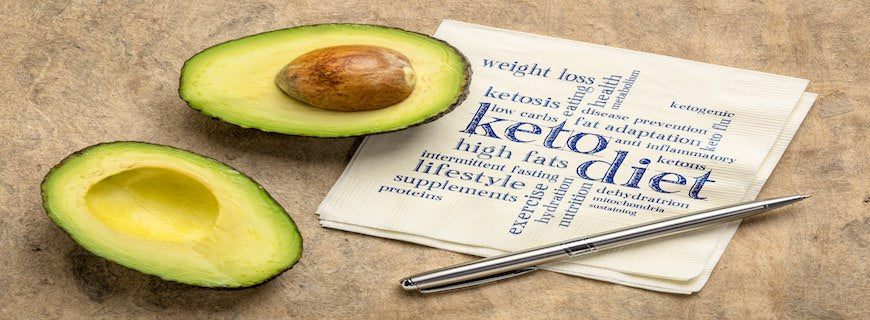The ketogenic diet has been hailed by a generation of savvy health and fitness enthusiasts – and for good reason. After all, the high-fat, low-carb diet’s ability to torch body fat, tackle type-2 diabetes and improve brain health is legendary.
It’s not plain sailing, though: the keto diet is hard work. And it can be even harder when keto flu strikes.
In this article, we’ll run you through the common side effects of the ketogenic diet, including those typically associated with the dreaded keto flu.
While not strictly a flu, these symptoms can quickly drain your enthusiasm for continuing with the keto diet. Although they’re only temporary, it’s good to know how to deal with them as and when keto flu rears its head.
Read on to find out about the symptoms to watch out for, as well as the effective fixes you can deploy.
What is Keto Flu, What are the Symptoms?
Keto flu is a name given to a raft of flu-like symptoms which occur in people embarking on the ketogenic diet.
The symptoms tend to crop up just as your body shifts from burning glucose for fuel to burning fat.
This metabolic switch is a gradual process, as the body starts to tap into an alternative fuel source when blood sugar is running low. As such, keto flu isn’t something that usually happens overnight.
The majority of keto dieters report experiencing their first symptoms of keto flu towards the end of their first week on keto.
Before they arrive you’ll likely be too busy focusing on ignoring powerful sugar cravings: the insistent voice in your head that urges you to abandon this keto folly and please just eat some simple carbohydrates!
Some people bow to sugar cravings but if you’re already sold on the keto diet, and looking forward to more energy, weight loss and the mental clarity engendered by the brain’s access to ketones, you should embrace the challenge and fight them off.
However as the days pass, insulin levels drop and your liver starts to convert fat into ketones; at this point your body excretes extra sodium and water in your urine and keto flu starts to take hold.
The most common keto flu symptoms are given below.
• Sore throat
• Headache
• Tiredness or insomnia
• Congestion or runny nose
• Back pain
• Dizziness
• Anxiety and irritability
• Brain fog
• Earache
• Vomiting
Doesn’t sound great, does it? But don’t fret: keto flu doesn’t last long and when you come out the other side, you can look forward to a complete reversal of the symptoms.
Where before you had been tired and lacking in concentration, you’ll experience a spike in energy levels and a sharpened focus.
Does Everyone Get Keto Flu?
The response to the keto transition will vary from person to person and can depend on how reliant upon carbohydrates you were before embarking on the diet.
While some people feel fine as they move towards ketosis, experiencing little more than a moderate sense of tiredness and manageable carb cravings, others might battle several symptoms at once while their body taps into its new fuel source.
Remember, keto flu symptoms generally go away all by themselves within a few days.
How to Avoid (Or Survive) Keto Flu: 6 Effective Remedies
As mentioned above, your kidneys dump extra sodium and water in your urine as you adapt to the ketogenic diet. And this filtration process is at least partly responsible for symptoms of the keto flu.
The solution? Replace some of the sodium and water you are excreting. Use a good-quality Himalayan or sea salt salt and sip water throughout the day.
Better still, drink filtered, mineral-rich alkaline water which will supply you with the alkaline minerals the keto diet is known to deplete.
You can also minimise your risk of experiencing keto flu by starting slowly, so perhaps adopting a low-carb diet before launching headlong into the keto diet.
If it’s too late and you’re already in the midst of full-blown keto flu, don’t worry: there are several coping mechanisms and ways to relieve the symptoms of it:
• Up the electrolytes
Loss of electrolytes is a common side effect of the keto diet, so increasing your intake of sodium, potassium and magnesium is smart. As well as drinking mineral water and being more liberal with the salt shaker, think about taking an electrolyte supplement. Our organic plant-based Electrolytes contain five essential electrolytes (those listed above plus calcium and chloride) as well as 72 trace minerals, and has a pleasant pineapple-coconut flavour. Even if you’re free of keto flu symptoms, you may require additional electrolytes, particularly if you engage in exercise. Listen to your body.
• Eat more fat
The keto flu can sometimes be due to insufficient fat consumption. It could be that you are devouring too much meat and protein and not enough healthy fats, including omega-3s and omega-6s. Be liberal with your usage of extra-virgin or avocado oil, eat oily fish (or take an omega-3 fish oil), grass-fed butter, avocado, coconut oil, the works. As well as helping to remedy keto flu, a higher fat intake will help with satiety and expedite ketosis.
• Use instant ketones
Ketone supplements – so-called ‘instant’ ketones –contain exogenous ketones such as beta-hydroxybutyrate (BHB), which are identical to those produced naturally by the body. The reason they can help with the keto flu is because they quicken the process of fat adaptation. Other benefits of exogenous ketones include improved energy and focus, less cravings and greater weight loss.
• Eat plant protein
There’s no shortage of protein or fat in the keto diet, but some people can go overboard on the meat protein which has the twin disadvantages of preventing you entering ketosis and also overloading the bowel. And there is another unintended consequence: if you take too much protein, the body will break down amino acids to produce – wait for it – sugar (glucose).
Opting for some clean sources of plant protein is a great idea, as it will ensure that you receive the phytonutrients and carotenoids you might otherwise miss out on when prioritising fats and animal protein. Food wise, make sure you’re eating nuts, seeds, nut butters, tempeh, legumes.
Conclusion
Keto flu is horrible, but by following our guidance you should be able to avoid keto flu or at least minimise the worst of the symptoms when they appear.
If you find that you’ve successfully shrugged off keto flu, only for it to return, it’s possible your protein intake is a little too high. Moderate and monitor to get over the hurdle.
Of course, you’ll want to know when you’re in ketosis – which is where ketone test strips come in.
Do you have any tips for overcoming the keto flu that we haven’t covered? We’d love to hear about them. Hit the Contact tab at the top of this page to get in touch.
Water for Health Ltd began trading in 2007 with the goal of positively affecting the lives of many. We still retain that mission because we believe that proper hydration and nutrition can make a massive difference to people’s health and quality of life. Click here to find out more.




























Leave a comment